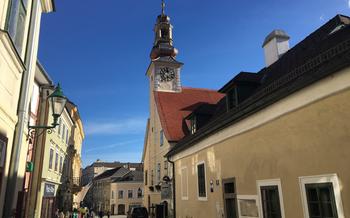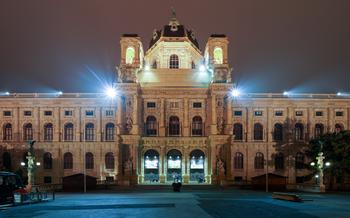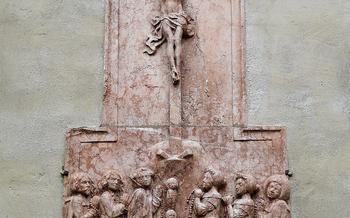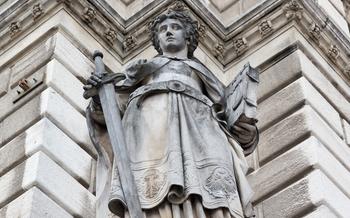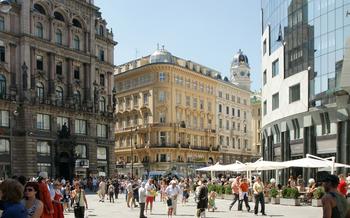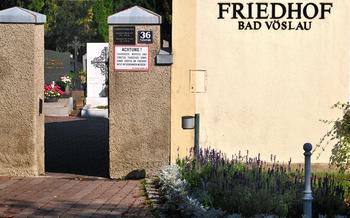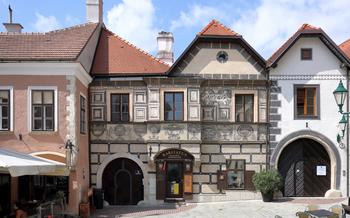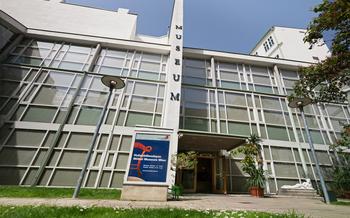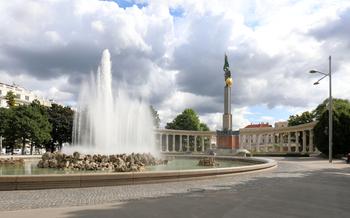
Kunsthistorisches Museum, Vienna
- Bad Vöslau: A Perfect Destination for Art and Culture
- Kunsthistorisches Museum, Vienna: A Treasure Trove of Art and History
- Exploring the Museum's Collections
- Unveiling the Treasure Chamber
- The Picture Gallery
- Ancient Egypt in Vienna
- Music and Art in Dialogue
- The Imperial Carriage Museum
- Getting There:
- Where to Stay
- Where to Eat
- Exploring Beyond the Museum
- Insider Tip:
Bad Vöslau: A Perfect Destination for Art and Culture
Bad Vöslau, nestled in the picturesque Triesting Valley of Lower Austria, is a charming town steeped in history and brimming with cultural attractions. Situated just a short distance from Vienna, the country's vibrant capital, Bad Vöslau offers visitors a wealth of opportunities to immerse themselves in art, music, and history. Its proximity to Vienna, a renowned cultural hub with world-class museums, theaters, and opera houses, makes it an ideal destination for those seeking a diverse and enriching cultural experience.
Bad Vöslau is home to a remarkable collection of museums, galleries, and musical venues, showcasing a diverse range of artistic expressions. Throughout the year, the town hosts a variety of events and festivals that celebrate local and international talent, providing visitors with unique opportunities to engage with the arts and experience the vibrant cultural scene of Bad Vöslau. Whether you are an art enthusiast, a history buff, or simply seeking a delightful cultural getaway, Bad Vöslau is sure to captivate and inspire you.
Kunsthistorisches Museum, Vienna: A Treasure Trove of Art and History
With a collection spanning over 6,000 years of art history, the Kunsthistorisches Museum in Vienna is a must-see for any art enthusiast visiting the city. Founded in 1891, the museum is housed in a grand neo-Renaissance building on the Ringstraße, a majestic boulevard lined with impressive historical structures. The museum's exterior is as captivating as its interior, adorned with intricate sculptures, colorful frescoes, and a grand dome that dominates the skyline.
The Kunsthistorisches Museum is home to one of the most significant art collections globally, showcasing masterpieces from various periods and cultures. Art lovers can marvel at works by renowned artists such as Pieter Bruegel the Elder, Caravaggio, Titian, Rubens, Rembrandt, Velázquez, and many more. The museum's collection is organized into various departments, each showcasing a specific genre or period. Visitors can explore the Egyptian and Near Eastern Collection, the Greek and Roman Collection, the Collection of Arms and Armor, the Sculpture and Decorative Arts Collection, and the Picture Gallery, among others.
One of the highlights of the Kunsthistorisches Museum is the Picture Gallery, which houses an impressive collection of paintings from the Middle Ages to the 19th century. Visitors can admire works by iconic artists such as Albrecht Dürer, Raphael, Leonardo da Vinci, and Vincent van Gogh. The Picture Gallery also features special exhibitions focusing on specific artists, themes, or historical periods, offering visitors a chance to delve deeper into the world of art history.
Exploring the Museum's Collections
The Kunsthistorisches Museum houses a diverse array of collections, each offering a glimpse into different civilizations and artistic periods.
The Egyptian and Near Eastern Collection:
Step into the realm of ancient Egypt and the Near East, where mummies, sarcophagi, and hieroglyphs tell tales of forgotten civilizations. Marvel at the intricately carved statues of Egyptian gods and goddesses, and decipher the secrets of the ancient written word as you explore the vast collection of papyri.
The Greek and Roman Collection:
Journey back to the classical world of Greece and Rome, where marble sculptures and shimmering mosaics immortalize the gods, heroes, and legends of antiquity. Gaze upon the serene beauty of the Venus of Ephesus and marvel at the intricate details of the Alexander Mosaic, a masterpiece depicting the legendary battle between Alexander the Great and King Darius III of Persia.
The Collection of Arms and Armor:
Witness the evolution of warfare through the ages as you explore the museum's impressive collection of arms and armor. From gleaming suits of plate armor worn by medieval knights to intricate firearms used by Renaissance armies, this collection offers a fascinating glimpse into the history of combat and the tools used to wage war.
The Sculpture and Decorative Arts Collection:
Immerse yourself in the splendor of Renaissance and Baroque art as you wander through the galleries dedicated to sculpture and decorative arts. Admire the delicate carvings of ivory and wood, the intricate designs of tapestries and textiles, and the shimmering brilliance of gold and silver objects that adorned the palaces of Europe's elite.
Unveiling the Treasure Chamber
Nestled within the Kunsthistorisches Museum, the Treasure Chamber is a dazzling display of opulence and artistry. Step into this magnificent chamber and discover the grandeur of the Habsburg dynasty, whose reign spanned centuries. Marvel at the Habsburg Imperial Treasury, where crown jewels, scepters, and orbs shimmer under the soft glow of the chandeliers. Admire the Secular Treasury's exquisite collection of rare coins, medals, and precious objects, each piece a testament to the Habsburgs' wealth and power.
Delve deeper into the Ecclesiastical Treasury, where sacred artifacts and vestments once adorned the imperial court. Gaze upon intricate chalices, ornate crucifixes, and shimmering reliquaries, each imbued with religious significance. Guided tours through the Treasure Chamber offer an in-depth exploration of these priceless treasures, revealing the stories, legends, and symbolism behind each masterpiece. Don't miss this opportunity to immerse yourself in the lavishness of the Habsburg dynasty and witness the splendor of their reign firsthand.
The Picture Gallery
The Picture Gallery at the Kunsthistorisches Museum is a treasure trove of paintings from the Middle Ages to the 19th century. With works by masters like Dürer, Rembrandt, and Velázquez, the collection is a testament to the museum's commitment to preserving and showcasing the finest examples of European art.
Visitors can wander through the galleries, marveling at the intricate details of early Flemish paintings, the dramatic chiaroscuro of the Italian Renaissance, and the vibrant colors of the Dutch Golden Age. Each room offers a unique glimpse into a different era of art history, allowing visitors to trace the evolution of painting styles and techniques over time.
Highlights of the collection include Dürer's "Self-Portrait at the Age of 28," Rembrandt's "The Raising of Lazarus," and Velázquez's "Las Meninas." These iconic works, along with many others, have made the Picture Gallery one of the most popular attractions at the Kunsthistorisches Museum.
In addition to the permanent collection, the Picture Gallery also hosts special exhibitions focusing on specific artists or themes. These exhibitions provide an opportunity to delve deeper into the work of individual masters or to explore particular artistic movements in greater detail.
To enhance the viewing experience, the museum offers audio guides that provide insightful commentary on selected works of art. Visitors can also participate in guided tours led by experienced art historians, who can share their knowledge and expertise about the museum's collection.
Ancient Egypt in Vienna
Vienna boasts a rich collection of ancient Egyptian artifacts and cultural treasures, housed in the Egyptian Museum and Papyrus Collection and the Afro-Asiatic Institute. The Egyptian Museum, located in the Hofburg Palace, displays an impressive array of mummies, sarcophagi, and hieroglyphs, providing a glimpse into the ancient civilization's beliefs and funerary practices. The Afro-Asiatic Institute, a research center dedicated to Egyptian studies, organizes exhibitions and lectures on Egyptian history and culture, offering visitors the opportunity to delve deeper into this fascinating subject.
For those seeking a more immersive experience, the institute offers courses in hieroglyphics and the ancient Egyptian language, allowing visitors to unlock the secrets of this ancient script. The Kunsthistorisches Museum also contributes to the city's Egyptian heritage through its collection of Egyptian artifacts, including sculptures, jewelry, and everyday objects, providing a comprehensive overview of ancient Egyptian life and culture.
Music and Art in Dialogue
The Kunsthistorisches Museum's Music Collection, housed within the museum's walls, is a treasure trove for music enthusiasts. It boasts a remarkable assemblage of musical instruments, manuscripts, and personal belongings of renowned composers, providing a fascinating glimpse into the world of music and its interplay with the visual arts.
Among the highlights of the collection are rare and exquisitely crafted instruments, such as viols, lutes, and harpsichords, that once graced the courts of European nobility. Visitors can marvel at the craftsmanship and artistry of these instruments, which were not only functional but also works of art in their own right. The collection also features original manuscripts of musical compositions by great masters, including Mozart, Beethoven, and Schubert, offering a tangible connection to their creative genius.
To further enhance the visitor experience, the Kunsthistorisches Museum regularly hosts concerts and recitals in its auditorium. These performances showcase a diverse repertoire of classical music, from early Baroque to contemporary compositions, performed by renowned musicians and ensembles. The museum also collaborates with music institutions and conservatories to present special events, such as chamber music concerts and lecture-recitals, that explore the connections between music and other art forms.
Through its music collection and events, the Kunsthistorisches Museum offers visitors a unique opportunity to experience the interplay between music and visual art. Whether it's admiring the intricate designs of historical instruments, delving into the manuscripts of musical masterpieces, or attending a live concert in the museum's elegant setting, visitors can immerse themselves in the harmonious convergence of these two artistic realms.
The Imperial Carriage Museum
Situated in the sprawling grounds of Schönbrunn Palace, the Imperial Carriage Museum offers a fascinating glimpse into the opulent world of Habsburg transportation. Step into a bygone era as you marvel at the exquisite carriages that once conveyed emperors, empresses, and their entourage. Among the highlights is the grand coronation coach, a symbol of imperial power and splendor. Adorned with intricate carvings, gilded embellishments, and plush interiors, it served as the majestic conveyance for Habsburg monarchs during their coronation ceremonies. The museum also houses the funeral carriage of Empress Elisabeth, known as Sisi, a somber yet ornate vehicle that carried her to her final resting place. Guided tours are available to delve deeper into the history of imperial transportation and the craftsmanship that went into creating these remarkable carriages.
Getting There:
Reaching the Kunsthistorisches Museum in Vienna from Bad Vöslau is a convenient and straightforward journey. The town is well-connected to Vienna by multiple transportation options, ensuring a hassle-free travel experience.
For those who prefer the ease and flexibility of public transport, regular train services operate between Bad Vöslau and Vienna. Trains depart from Bad Vöslau Bahnhof and arrive at Wien Hauptbahnhof, the city's main railway station. From there, visitors can take the U-Bahn (metro) line U1 to Karlsplatz station, which is just a short walk from the museum.
Alternatively, travelers can opt for the scenic route and take a bus from Bad Vöslau to Vienna. Buses depart from the Bad Vöslau bus station and arrive at the Vienna International Busterminal (VIB). From there, visitors can take the U-Bahn line U1 or U4 to Karlsplatz station.
For those arriving by car, the Kunsthistorisches Museum is easily accessible via the A2 motorway. Take the exit for "Wien-Zentrum" and follow the signs to the museum. Parking is available in the museum's underground garage or in nearby public parking lots.
If you prefer a guided experience, several tour operators offer day trips from Vienna to Bad Vöslau, including visits to the Kunsthistorisches Museum. These tours often include transportation, guided tours of the museum, and additional sightseeing opportunities, providing a comprehensive and hassle-free way to explore the town's cultural treasures.
Where to Stay
When planning your trip to Bad Vöslau and Vienna, a crucial aspect to consider is finding suitable accommodations. Bad Vöslau offers a range of hotels and guesthouses catering to different budgets and preferences. For a more immersive experience, consider staying in a traditional Austrian guesthouse to savor the local charm and hospitality.
For those seeking a luxurious stay, the Grand Hotel Wien, located in the heart of Vienna, offers opulent accommodations and stunning views of the city. If you're on a budget, numerous affordable options are available, such as hostels and guesthouses, providing a comfortable stay without breaking the bank.
To be close to the Kunsthistorisches Museum and other attractions, consider booking a hotel in the Innere Stadt district. This vibrant area offers a wide range of accommodation options, from cozy bed and breakfasts to elegant boutique hotels.
Online booking platforms like Booking.com and Airbnb provide convenient ways to search for accommodations, compare prices, and read reviews from fellow travelers. Take advantage of early booking discounts and special offers to secure the best deals.
Whether you choose to stay in Bad Vöslau or Vienna, ensure your accommodation is easily accessible by public transport or offers parking facilities if you're traveling by car. This will allow you to move around conveniently and make the most of your time exploring the region's cultural treasures.
Where to Eat
Bad Vöslau offers a diverse culinary scene, catering to various tastes and budgets. Indulge in traditional Austrian cuisine at local restaurants and cafés, where you can savor hearty dishes like Wiener Schnitzel or Tafelspitz. For a more international experience, explore the town's selection of Italian, Asian, and Mediterranean restaurants.
Budget-friendly options include cozy cafés and traditional Gasthäuser, where you can enjoy a satisfying meal at a reasonable price. If you're looking for a fine dining experience, Bad Vöslau boasts several elegant restaurants serving exquisite cuisine with a modern twist.
For those with dietary restrictions, there are plenty of vegetarian and vegan-friendly options available. Look for restaurants that display the "Grüne Küche" label, indicating their commitment to sustainable and plant-based cuisine.
To fully immerse yourself in the local culture, don't miss the opportunity to visit one of Bad Vöslau's Heurigen, traditional wine taverns serving local wines and simple, yet delicious food.
No matter your preference, Bad Vöslau's culinary scene offers something for everyone. Embrace the town's vibrant food culture and indulge in a memorable dining experience.
Exploring Beyond the Museum
Bad Vöslau offers more than just the Kunsthistorisches Museum. Immerse yourself in the town's rich cultural tapestry by visiting the local thermal baths, renowned for their therapeutic waters and opulent architecture. Take a leisurely stroll through the picturesque vineyards and savor the flavors of local wines at one of the many charming wineries.
Venture beyond Bad Vöslau to discover the neighboring towns of Baden and Mödling, each boasting unique attractions. Baden, known for its thermal springs and elegant villas, offers a tranquil escape. In Mödling, explore the medieval castle, wander through the historic center, and visit the Beethoven Museum, dedicated to the life and works of the legendary composer.
Indulge in culinary experiences by embarking on a wine tasting tour in the surrounding region. Sample the exquisite wines produced in the local vineyards while enjoying panoramic views of the rolling hills. Don't miss the chance to savor traditional Austrian cuisine at one of the many gemütliche restaurants, offering hearty dishes and warm hospitality.
Immerse yourself in the vibrant local festivals and events that celebrate Bad Vöslau's rich heritage. From traditional folk festivals to contemporary art exhibitions, there's always something to experience. Embrace the lively atmosphere, engage with the friendly locals, and create lasting memories in this charming town.
Insider Tip:
Beyond the famous Kunsthistorisches Museum, Bad Vöslau holds hidden gems for art enthusiasts.
-
Discover the Art Nouveau treasures: Explore the town's Art Nouveau architecture, including the elegant villas along Hauptstraße and the striking Gemeindeamt (town hall).
-
Visit the Stadtmuseum Bad Vöslau: Delve into the local history and culture at this museum, showcasing exhibits on the town's thermal springs, famous visitors, and artistic traditions.
-
Stroll through the Kurpark: Find tranquility and inspiration in this beautiful park, featuring sculptures, a rose garden, and a serene atmosphere.
-
Attend the annual Art & Culture Festival: Experience a vibrant celebration of local and international artists during this summer festival, offering exhibitions, performances, and workshops.
-
Engage with local artists: Connect with talented local artists through workshops, galleries, and art markets, gaining insights into the town's contemporary art scene.
